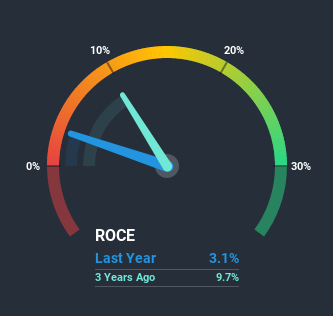What Mattel's (NASDAQ:MAT) Returns On Capital Can Tell Us

If we're looking to avoid a business that is in decline, what are the trends that can warn us ahead of time? Typically, we'll see the trend of both return on capital employed (ROCE) declining and this usually coincides with a decreasing amount of capital employed. Basically the company is earning less on its investments and it is also reducing its total assets. In light of that, from a first glance at Mattel (NASDAQ:MAT), we've spotted some signs that it could be struggling, so let's investigate.
Return On Capital Employed (ROCE): What is it?
Just to clarify if you're unsure, ROCE is a metric for evaluating how much pre-tax income (in percentage terms) a company earns on the capital invested in its business. The formula for this calculation on Mattel is:
Return on Capital Employed = Earnings Before Interest and Tax (EBIT) ÷ (Total Assets - Current Liabilities)
0.031 = US$112m ÷ (US$5.0b - US$1.4b) (Based on the trailing twelve months to June 2020).
So, Mattel has an ROCE of 3.1%. In absolute terms, that's a low return and it also under-performs the Leisure industry average of 13%.
See our latest analysis for Mattel
Above you can see how the current ROCE for Mattel compares to its prior returns on capital, but there's only so much you can tell from the past. If you'd like to see what analysts are forecasting going forward, you should check out our free report for Mattel.
What The Trend Of ROCE Can Tell Us
We are a bit anxious about the trends of ROCE at Mattel. Unfortunately, returns have declined substantially over the last five years to the 3.1% we see today. In addition to that, Mattel is now employing 31% less capital than it was five years ago. When you see both ROCE and capital employed diminishing, it can often be a sign of a mature and shrinking business that might be in structural decline. Typically businesses that exhibit these characteristics aren't the ones that tend to multiply over the long term, because statistically speaking, they've already gone through the growth phase of their life cycle.
On a side note, Mattel's current liabilities have increased over the last five years to 28% of total assets, effectively distorting the ROCE to some degree. Without this increase, it's likely that ROCE would be even lower than 3.1%. Keep an eye on this ratio, because the business could encounter some new risks if this metric gets too high.
What We Can Learn From Mattel's ROCE
To see Mattel reducing the capital employed in the business in tandem with diminishing returns, is concerning. Investors haven't taken kindly to these developments, since the stock has declined 43% from where it was five years ago. Unless these trends revert to a more positive trajectory, we would look elsewhere.
If you'd like to know more about Mattel, we've spotted 2 warning signs, and 1 of them can't be ignored.
For those who like to invest in solid companies, check out this free list of companies with solid balance sheets and high returns on equity.
This article by Simply Wall St is general in nature. It does not constitute a recommendation to buy or sell any stock, and does not take account of your objectives, or your financial situation. We aim to bring you long-term focused analysis driven by fundamental data. Note that our analysis may not factor in the latest price-sensitive company announcements or qualitative material. Simply Wall St has no position in any stocks mentioned.
Have feedback on this article? Concerned about the content? Get in touch with us directly. Alternatively, email editorial-team@simplywallst.com.

